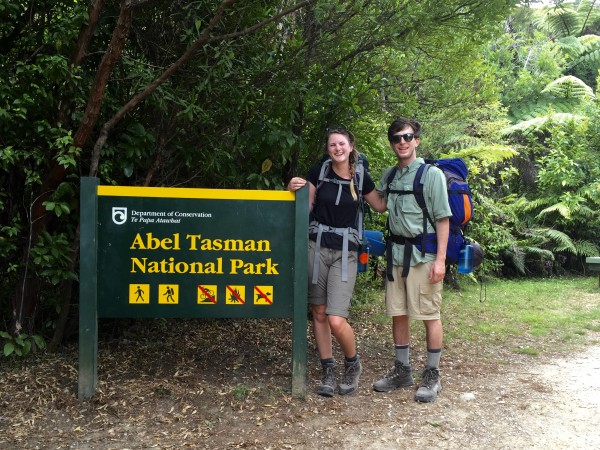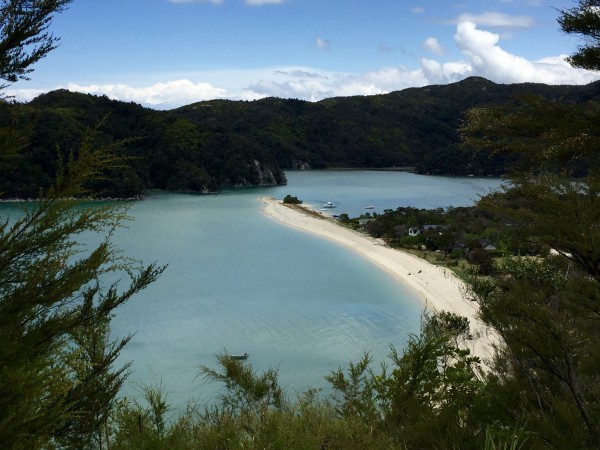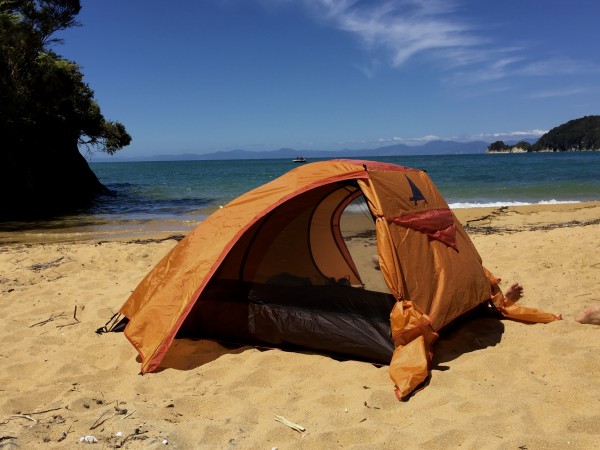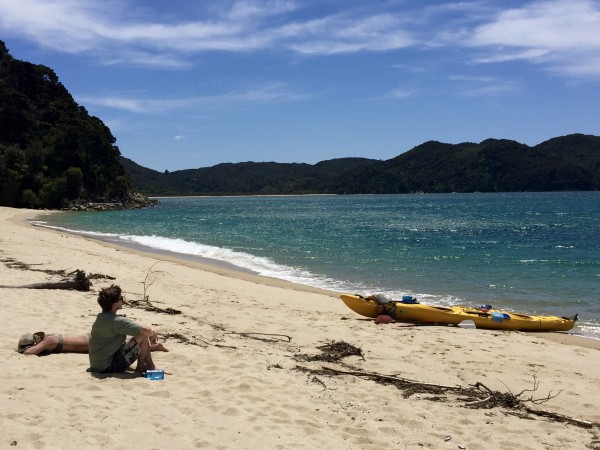

Starting with ‘Kiwi’
“Say ‘kiwi,’” instructed a motherly woman as she snapped our picture. We laughed, obeying as we leaned on the entrance sign to Abel Tasman National Park.
But even after the chuckle faded, the comment stuck with me. It seemed incongruous with what I’d been told, and experienced myself, of the Kiwis.
Nicknamed after their national bird, the people of New Zealand should be brimming with national pride.
And yet, they are often reluctant to boast about their country — despite living amid what is easily some of the most beautiful terrain on the planet.
Abel Tasman National Park is one of those places. Catch it during good weather and emerald saltwater laps gently against golden shores, framed by a coastline of sunny rainforest.
The cliché arises from the granite sand; flecks of feldspar give it a gold hue. The sun is hot, and the water just cold enough for pleasant swimming and boating.
Exploring Abel Tasman National Park
On our first morning, we stuffed the necessities — a tube of sunscreen, a lightweight mesh tent for bug protection, and food for a day and a half — into our rented ocean kayak.
It was pleasantly surprised that the longer items wedged neatly into the bow and stern, leaving room for bulkier items in the middle hatch.
Shimmying into the neoprene spray skirts, we set out from Marahau, the small town at the southern end of the national park.
The next afternoon, a water taxi would relive us of the boats in exchange for our large packs and heavier camping gear, which we’d need to hike back. For now, however, we were free to roam as we wished.
Fisherman Island
Eyeing an empty stretch of beach, we sidled up to Fisherman Island and pulled in for lunch.
The beach was just big enough for the four of us to spread out with our pair of kayaks, and we were so transfixed on the distant peaks that we failed to notice how quickly the tide rolled in until it was threatening to make off with our boats.
With little choice, we threw our lunch bags back in the boats and shoved off, having had our first encounter with the severe tides of the area.
It’s an ephemerality that merely adds to the place’s mystique — what is a beach at ten o’clock may be nothing but saltwater by noon.
That night, we camped right on the sand at a boat-in beach with only one other group, gazing across the water at the setting sun and the island we’d been hurried off of.
Sandbars rose and dove before our eyes as the tide shrank, then rolled back in. We luxuriated in our private beach, dipping into the water to cool down every so often, as if to remind ourselves this paradise was real.

The Next Morning
We embarked on our second day of paddling and encountered some difficult sections around rocky, exposed points.
While the “Mad Mile” did not live up to its name, we ended up paddling Foul Point late in the day and paid for it.
Intense winds and choppy seas made for arduous going, but eventually we made it to the tree-lined Onetahuti Beach and threw ourselves on the warm sand, exhausted.
A long, slender crescent much bigger than the previous beach, Onetahuti sits on the Abel Tasman Coastal Track and thus sees many more campers.
It also has many more animals, as the area is part of a protected marine reserve. Fish and rays are common, as are glowworms — if you can find them.
That evening around dusk, a fortuitous curiosity led me into a cave at the end of the beach that had been uncovered by the outgoing tide.
Upon extinguishing my headlamp, I was floored to discover that the light hadn’t scared the cave’s other occupants into extinguishing themselves: the damp cave ceiling above my head was lined with a constellation of tiny, glowing blue larvae.

Early the following morning, we were awoken by a bizarre whooshing sound that seemed to emanate from directly above the opaque orange roof of the tent.
Watching the Beautiful Birds
Bleary-eyed, we exited to find a number of awkward, colorful birds heaving themselves back and forth overhead.
The comically stocky birds seemed almost too large to support themselves in the air; upon launching they’d flap intensely, struggling to sustain their flight, and create a bizarrely loud sound in the process.
We later learned that these wood pigeons are not alone in New Zealand’s extensive catalog of flightless birds and insects.
They evolved into such lumbering creatures in the absence of natural predators, much like the penguins who also inhabit Abel Tasman (although we sadly did not see any there).
With no chance of returning to sleep amid the cacophony of straining wings, we set about making breakfast and breaking down camp.
We reorganized the backpacks that been left for us on the beach the previous afternoon and set out on the second half of our journey, during which we would trek back to Marahau along the Abel Tasman Coastal Track, one of the Department of Conservation’s “Great Walks.”

While we’d paddled directly across numerous bays in our kayaks, pedestrians are forced to stray inland to get around the myriad inlets of water. In certain places, there exists the option for a low-tide crossing over the sand.
At high tide, however, you’ll inevitably be taking a much longer way around, crossing suspension bridges in the humid rainforest and climbing high ridges with sweeping views of the coastline below.
Taking the long route is for the best in Abel Tasman. Traveling on land put us in close contact with the rich flora and fauna of the park (certainly closer with it than the park’s namesake, a Dutch explorer who never actually stepped foot there).
Seeing the Marine Life
Although we’d seen fur seals and other marine life out on the water, the thick fern forests hid all manner of birds. We learned to identify them by sound as they called to us, from the squeaky tom tit to the mellifluous bell bird.
We’d been granted an extraordinary weather window, even for a notoriously sunny part of the South Island, but it’s obvious that the area frequently receives deluges of rain.
We tramped for many miles through lush vegetation, alternately chatting and ruminating on our surroundings as we rounded every kink of the hard-packed mud trail.
We camped at Anchorage that night and sat up by the fire after it grew dark, perhaps to ward off the sandflies with the smoke, but really we were relishing what was soon to be but a memory.

As quickly as the blink of a camera shutter, we found ourselves back where we had started the next afternoon, just as a smattering of drops began speckling the rain cover on my pack.
As I yanked off my boots and stripped my muddy socks, I began to think about the national character born out of such a magnificent country. Perhaps the Kiwis’ reticence to brag is not a lack of pride in their home.
Rather, it is a sense of protection. After all, I thought, examining a fresh blister on my pinkie toe, if everyone knew about this place, there wouldn’t be enough space for all of us.
If You Go
Rent kayaks from any one of the many rental companies in Marahau for the first leg of a multi-day trip so you can return at your own pace. General information can be found at https://www.doc.govt.nz/parks-and-recreation/places-to-go/nelson-tasman/places/abel-tasman-national-park
Author bio: An arts and travel writer, Ali Van Houten loves stories that celebrate the adventure and creativity of the human spirit — both physically and intellectually. Her particular areas of interest include outdoor escapades, like backpacking and horseback riding, and music (everything from electronic to bluegrass). She earned a bachelor’s degree in English with a specialization in Modern Literature and Critical Theory, as well as a minor from the Professional Editing track of the extremely selective Professional Writing program at the University of California, Santa Barbara. She is also fortunate enough to have studied in the distinguished School of English at Trinity College, Dublin in Ireland. The San Francisco Bay Area is her home, but she loves to travel. When she’s not writing, you’ll find her exploring on foot, be it in the wilderness with a thirty-pound pack or in an urban environment, cup of coffee in hand.
[mappress mapid=”971″]
- Top 10 Things to Do in Ireland - April 25, 2024
- How to Get Around in Sydney: A Local’s Guide to Traveling Around Sydney - April 24, 2024
- The Low-Key Magic of Ghent, Belgium - April 22, 2024
